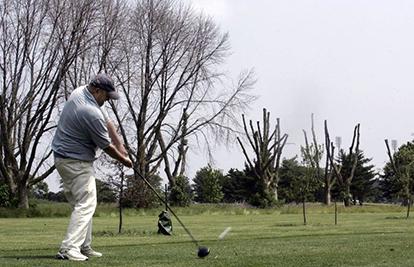 In the 12 years it has been buzzing around North America, the Emerald Ash Borer has been pretty busy. The tiny, invasive pest initially got off to a slow start in its first couple of years as an unwanted visitor, but has since been in the fastlane of a path to destruction, and any chances at controlling or even slowing its spread might be largely dependent on other non-native insect species.
In the 12 years it has been buzzing around North America, the Emerald Ash Borer has been pretty busy. The tiny, invasive pest initially got off to a slow start in its first couple of years as an unwanted visitor, but has since been in the fastlane of a path to destruction, and any chances at controlling or even slowing its spread might be largely dependent on other non-native insect species.
First found in the United States in 2002 in Michigan, EAB spread to Ontario, then Ohio, Maryland and Virginia throughout 2003. A year later, it was found in Indiana, but it had been quickly eradicated in Maryland. By 2005, it failed to increase its North American range, providing a brief glimmer of hope that its spread could be controlled and its population eradicated.
So much for hope.
Today, EAB is found in 24 states and two provinces in Canada. Its range has spread to previously unlikely locations, including southward to Tennessee and Georgia and westward into Kansas and Colorado. Scientists estimate that EAB has wiped out 8 billion trees worth as much as $280 million. More than $29 million is spent annually to combat the spread of EAB, according to research by the U.S. Department of Agriculture and the U.S. Forest Service.
And it's going to get worse.
It is believed that the pest that is native to eastern Asia and came to the U.S. aboard a Chinese freighter that docked in Detroit, eventually will reach the entire ash tree range in North America, an area that covers parts of at least 42 U.S. states and six Canadian provinces. Each ash borer, however, only flies a few miles throughout its lifecycle. Its rapid spread, says Dave Smitley, Ph.D., of Michigan State University, is largely blamed on moving infested firewood. All species of ash in North America are thought to be susceptible, scientists say.
"Yes, I believe EAB will eventually spread to all states with ash trees," Smitley said. "The natural range in eastern Asia covers a large gradient from cold to warm climates. We have already seen it spread to our northern-most states. I am not sure if there will be any warm temperature limitations."
Several companies have developed chemistries that have proven to be effective against EAB, but cost has made saving anything more than target trees economically unrealistic. Introduction of biological parasites has provided a more realistic approach to widespread control.
EAB populations have been largely unaffected by native parasitic wasps. However, parasitic wasps native to Asia, such as Oobius agrili, Spathius agrili and Tetrastichus planipennisi have been more effective, parasitising from 50 percent to 90 percent of the pest's ova and/or larvae. The non-native parasitic wasps are raised in and distributed from a USDA laboratory in Brighton, Michigan. Nearly 1 million parasitic wasps have been released since that site opened in 2009.

"Oobius agrili and Tetrastichus planipennisi have been recovered at release sites and their establishment and parasitism rates are gradually increasing," said Therese Poland, Ph.D., research entomologist at the U.S. Forest Service Northern Research Station in Lansing, Michigan. "They are currently being reared at the APHIS biocontrol rearing facility in Brighton. However, Spathius agrili has not been recovered at the sites where it has been released. It is believed that the climate here may be too cool for establishment since it was collected in southern China. It is no longer being reared and released."
Spathius agrili exhibited control of EAB larvae of up to 90 percent, but scientists believe the U.S. climate is too cold for it, so it is no longer raised at the Michigan lab. Research on a fourth non-native species, Spathius galinae, is under way, Poland said. That wasp is native to Russia, and scientists believe that its natural range could make it more adaptable as a control tool here.
Those interested in acquiring and releasing parasitic wasps must have a release permit issued by the USDA, which has a host of recommendations for the size of the wooded area that has been affected, age of the trees involved and density of EAB population at the site.
EAB kills ash trees by disrupting the uptake of water and nutrients through the trunk and into the upper reaches of the tree.
Adult females, which grow to about a half-inch in length and can be difficult to spot, create a hole in the bark into which they deposit their eggs. After hatching, the larvae feed on and chew galleries through the tissue beneath the bark layer, disrupting the tree's ability to move water and nutrients through its vascular system. In the spring, new adults chew through the bark and emerge, flying into the canopy to ingest ash leaves and the reproductive process begins all over again.
Symptoms of infestation include thinning of the canopy and sprouts growing from holes in the trunk that were created by the pests, along with a healthy population of voracious woodpeckers that find EAB especially pleasing to the palate.
Tree canopies can be wiped out within two years, and mature, healthy trees are dead usually within three to four years.

